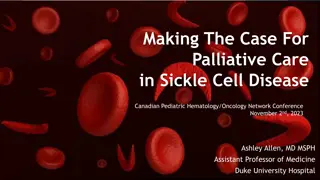Compounded Drugs in Hospice and Palliative Care: Enhancing Patient Comfort
Explore the utilization of compounded drugs in hospice and palliative care settings, focusing on addressing complex clinical issues like wounds, pain, infections, and more. Discover how medications like Phenytoin and Morphine are customized to alleviate symptoms and improve quality of life for terminally ill patients.
Download Presentation

Please find below an Image/Link to download the presentation.
The content on the website is provided AS IS for your information and personal use only. It may not be sold, licensed, or shared on other websites without obtaining consent from the author.If you encounter any issues during the download, it is possible that the publisher has removed the file from their server.
You are allowed to download the files provided on this website for personal or commercial use, subject to the condition that they are used lawfully. All files are the property of their respective owners.
The content on the website is provided AS IS for your information and personal use only. It may not be sold, licensed, or shared on other websites without obtaining consent from the author.
E N D
Presentation Transcript
COMPOUNDED DRUGS of Value in Hospice, End-of-Life, and Palliative Care John P. McNulty,, MD, FACP, FAAHPM George Muller, RPh Palliative Care Institute of Southeast Louisiana Compounding Business Services, Covington, LA
Objectives Discuss commonly prescribed drugs in hospice employed in formats not commercially available, and modified to a patient s need for these clinical problems: Wounds: decubitus; pain; infection; bleeding Nausea and Vomiting Pain and Dyspnea Bladder and Urinary problems Rectal and Anal problems
Drugs Haloperidol, Ativan, Benadryl, Reglan Morphine, Levorphanol, Methadone, Oxycodone, Lidocaine Ketamine oral, i.m., cream or gel, nasal spray Phenytoin paste or cream Metronidazole, chloramphenicol, thrombin, Monsel s Solution Bladder irrigations: acetic acid; KMnO4 Rectal Rocket
Phenytoin to heal Decubitus Ulcers Phenytoin was noted years ago in epileptic children on long-term phenytoin to develop overgrowth of gingeval tissue. Evidence has shown that Phenytoin can stimulate the regrowth of normal tissue in decubiti and other wounds if the tissue is otherwise healthy with adequate blood supply. Phenytoin 5% Paste 30 Gm is compounded and widely used in hospice settings.
Morphine Cream for Painful Wounds To relieve the pain caused by dressing wounds, or to relieve chronically painful wounds, Morphine 1% Cream can be applied to the wound 15 minutes before dressing, or every 4 hrs as needed for chronic pain. Morphine is effective on an open lesion, not on intact epidermis. There is no systemic absorption, and no additive effect on other opioids being given systemically.
Malignant Infected wounds of the Breast, Head and Neck Large, bleeding, necrotic, purulent, foul- smelling wounds due to head, neck, and breast neoplasms are difficult to manage, and cause distress to the patient, family and staff. One effective management, after cleansing the affected area, is to puff a mixture of powdered Flagyl and chloramphenicol (or cipro ) via a small plastic insufflator, or bellows, to the wound surface every one or two days.
Control of Bleeding in Wounds of Body Surface Thrombin is commonly used to control bleeding of oozing necrotic neoplastic lesions. Thrombin can be added to puffed drugs applied to control infection. It is expensive. Monsel s Solution, ferris subsulfate, an older compounded drug, coagulates bleeding from open wounds when painted or dabbed on the site, much like a styptic pencil. Used to stop bleeding from slice biopsies in dermatology and in colposcopy.
Nausea and Vomiting: HABR Effective evidence-based combination used for refractory nausea and vomiting. Haloperidol : acts on vomiting center( CTZ ) and dopamine receptors; Lorazepam: reduces cortical-induced nausea; Benadryl: acts on CTZ and blocks extrapyramidal side-effects of haloperidol and metoclopramide ( Reglan ). Metoclopramide: increases GI motility, acts on CTZ, dopamine and serotonin receptors.
HABR Usual combo: Haldol 1 mg; Ativan 1 mg; Benadryl 25 mg; Reglan 5 mg. Can decrease Haldol or Ativan to 0.5 mg or add Decadron. Oral capsule, short-acting: 1 cap q 6 hr prn, or long-acting: 1 cap q 12 hr. Available as a liquid. Rectal suppository ( same doses) 1 q 6-12 hr rectally as needed. Transdermal gel is no longer recommended.
Pain and Dyspnea Oral concentrate solutions of morphine, levorphanol, methadone, and oxycodone are often used to provide relief of pain or dyspnea in patients who are unable to swallow safely, especially in patients who are nearing death. Used in small doses given buccally or sublingually, absorption by some is mucosal, by others via the upper GI tract. Fentanyl and methadone absorb fastest.
Oral Opioid Concentrate Solution Morphine Morphine is commercially available as a fixed 20mg/ ml oral concentrate in a 30ml dropper bottle. When smaller or larger concentrations are desired for a patient, compounded morphine can be provided at a range from 10mg to 60 mg/ml, in 15ml to 30 ml dropper. Standard dose for pain or dyspnea is 5 mg subling. q 2-4 hr, but depending on the intensity of symptom distress, dose escalation at a more frequent time may be needed.
Methadone Oral Concentrate Methadone is often the drug needed for intractable pain. In patients unable to swallow, a concentrate suspension of methadone 20 mg /ml is most often used, supplied in a 30 ml dropper bottle, and because methadone is bitter, it is best flavored with chocolate, mint, and raspberry. Concentrations are available from 10-60 mg/ml in a 15 or 30 ml dropper.
Levorphanol and Oxycodone Oral Concentrate Solutions Levorphanol is compounded most often as a 4 mg/ml concentrate suspension in a 30 ml dropper bottle. It is best flavored with pina colada. Levorphanol is available in 2-8 mg/ml concentrations. Excellent alternative to methadone for refractory or neuropathic pain. Oxycodone oral concentrate, available commercially as 20mg/ml, can be compounded in other concentrations if needed, similar to oral morphine.
Nebulized Morphine Nebulized Morphine (or Hydromorphone) for the relief of dyspnea is controversial. It is not effective in chronic obstructive lung disease and interstitial pulmonary fibrosis. There is evidence that Morphine nebs help dyspnea in cancer patients, more quickly than opioids given systemically. It would seem likely that dyspnea due to CHF would be helped, based on morphine s dramatic effectiveness in acute pulmonary edema.
Nebulized Morphine compounding and dosing Should be prepared under strict aseptic conditions under a hood in a clean room enclosure Compounded as a 2.5mg or 5mg per vial concentration Concentrated as 2.5mg, normal dosage utilized, per 1ml or per 3ml vial Sterile vial has screw cap enabling simplified pouring into a nebulizer
Nebulized Lidocaine for Intractable Cough When usual treatments for a persistant cough due to cancer or chronic lung disease fail: Lidocaine 1 ml of 2% sterile solution added to 3 ml sterile saline can be nebulized every 3-4 hours. Should be prepared in a sterile aseptic environment if compounded Alternatively 1ml can be withdrawn via syringe from a manufactured 20ml vial and placed in a nebulizer with 3ml of normal saline from a sterile prepackaged vial
Urinary catheter clogging; Resistant urinary infection Cloudy or turbid urine not due to infection is often due to amorphous debris and/or phosphate crystals, which may obstruct urinary catheters. A simple, often successful remedy is to irrigate the catheter with 60 ml of 0.1% acetic acid solution once or twice daily An old, seldom used method to clear a lower GU resistant infection: Irrigate bladder with 1:10,000 KMnO4 sol. twice daily for 30 min.
Rectal and Anal Pain Pain due to anal fissure or thrombosed hemorrhoids has been effectively relieved by inserting a compounded Rectal Rocket into the anal canal. The Rocket remains overnight, held in place by flanges, allowing the lidocaine and hydrocortisone in the suppository base to be absorbed into the inflamed tissue. Morphine cream is also effective ( slide 5); as is Ketamine cream or gel ( next slide ).
Ketamine Ketamine, an anesthetic given i.v. in sub- anesthetic doses has been used for years to relieve neuropathic pain by blocking the n- methyl-d-aspartate receptor (NMDA) in the spinal cord It is possible to use ketamine orally, i.m., in creams and gels, and by nasal spray for pain relief, and relief of depression in some cases. Ketamine gels or creams, 5-10%, applied locally to painful body regions are useful.
Conclusion Compounded drugs allow flexibility in dosing, and access to drugs in delivery systems not commercially available. Contact your local compounding pharmacist to get more specific information about these compounded drug uses, the formulas, the directions for patients, the contraindications for their use in specific patients, and the cost.























